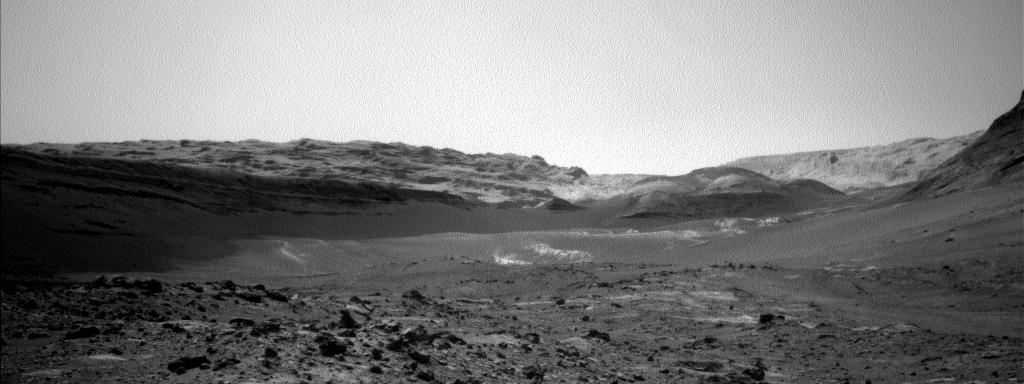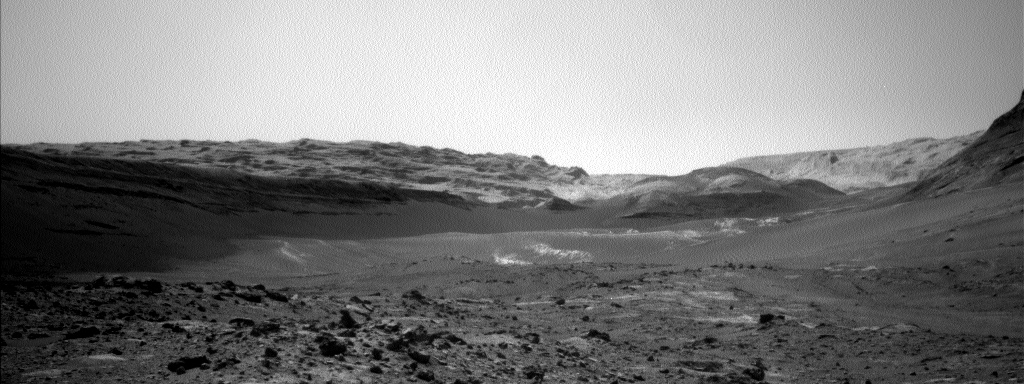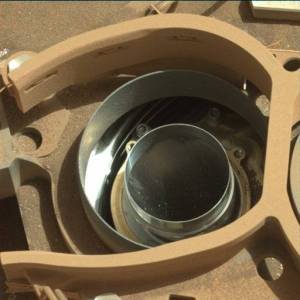Curiosity Navigation Curiosity Home Mission Overview Where is Curiosity? Mission Updates Science Overview Instruments Highlights Exploration Goals News and Features Multimedia Curiosity Raw Images Images Videos Audio More Resources Mars Missions Mars Sample Return Mars Perseverance Rover Mars Curiosity Rover MAVEN Mars Reconnaissance Orbiter Mars Odyssey More Mars Missions The Solar System The Sun Mercury Venus Earth The Moon Mars Jupiter Saturn Uranus Neptune Pluto & Dwarf Planets Asteroids, Comets & Meteors The Kuiper Belt The Oort Cloud 2 min read
Sols 4275-4276: A Familiar View  NASA’s Mars rover Curiosity acquired this image using its Left Navigation Camera on sol 4272 — Martian day 4,272 of the Mars Science Laboratory mission – on Aug. 12, 2024 at 12:06:27 UTC. NASA/JPL-Caltech Earth planning date: Wednesday, Aug. 14, 2024
NASA’s Mars rover Curiosity acquired this image using its Left Navigation Camera on sol 4272 — Martian day 4,272 of the Mars Science Laboratory mission – on Aug. 12, 2024 at 12:06:27 UTC. NASA/JPL-Caltech Earth planning date: Wednesday, Aug. 14, 2024
The star of today’s plan is SAM’s GCMS, which continues our analysis of the “Kings Canyon” drill sample. As Natalie mentioned, this is a relatively energy-hungry activity, but luckily our last plan left us in a good position to not only complete the GCMS experiment but also fit in some other science around it. Having spent a good deal of time in this location for our drill campaign, we’re getting really familiar with this area in a way we don’t get the opportunity to when we’re driving more often. This means lots of geology targets both near and far — a collection to which we’re adding in today’s plan. Nearby, we have two targets for ChemCam’s laser spectrometer, “Meysan Lake” and “Washburn Lake.” Further afield, ChemCam has long-distance mosaics of “Milestone Peak” and our constant companion for many sols, the Kukenan Butte. Mastcam will also be getting a mosaic of the Wilkerson Butte.
While the atmosphere is always with us, staying in one spot can also grant us good opportunities for keeping an eye on the current environment. We currently have a great view of a nearby sand patch, which you can see in the image above, and we’ve been taking full advantage with lots of dust devil movies, including one in today’s plan. We can also look out for wind-driven movement closer to home, which we’re doing with a Mastcam observation of the drill hole tailings and a Navcam observation of the dust that’s accumulated on the rover deck.
It’s not just near-surface dust we want to keep an eye on, though. The amount of dust suspended in the atmosphere varies throughout the year, and we’re continuing to keep track of that with regular tau observations. The optical depth, which is usually denoted by the Greek letter tau (hence our observation’s name), is a measure of how opaque or transparent the atmosphere is. At this time of year, in the midst of the dusty season, there tends to be more dust suspended in the atmosphere, meaning we cannot see quite as far, and we say the optical depth, or tau, is higher.
Written by Alex Innanen, Atmospheric Scientist at York University
Details Last Updated Aug 14, 2024 Related Terms Blogs
Keep Exploring Discover More Topics From NASA Mars
Mars is the fourth planet from the Sun, and the seventh largest. It’s the only planet we know of inhabited…

Explore this collection of Mars images, videos, resources, PDFs, and toolkits. Discover valuable content designed to inform, educate, and inspire,…

Each robotic explorer sent to the Red Planet has its own unique capabilities driven by science. Many attributes of a…

Mars Exploration: Science Goals
The key to understanding the past, present or future potential for life on Mars can be found in NASA’s four…



 2 min read Sols 4273-4274: Prep Rally
2 min read Sols 4273-4274: Prep Rally
 2 min read Sols 4270-4272: Sample for SAM
2 min read Sols 4270-4272: Sample for SAM
 2 min read Sols 4268-4269: Admiring Kings Canyon
2 min read Sols 4268-4269: Admiring Kings Canyon
